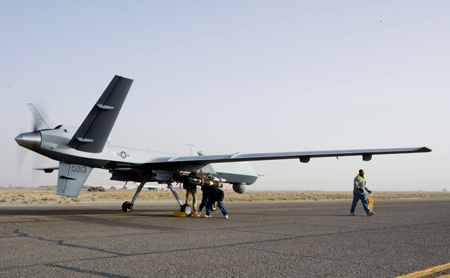The  Air Force’s decision to cap its fleet of MQ-1/MQ-9 remotely piloted aircraft at 65 combat air patrols was made in part due to tightening budgets, but also to ensure that there is a healthy balance between the intelligence-collecting RPA and their supporting information-processing infrastructure, said Secretary Michael Donley. “Our [RPA] sensors are collecting, and have been collecting, data at rates that vastly exceed what our analysts can fully exploit,” he told reporters during a roundtable in Washington, D.C., last week. He added, “It didn’t make any sense for us to continue to grow more collectors—capability to collect—if the capability to exploit and process beneath that was not keeping up.” By bolstering the processing-exploitation-dissemination architecture, having enough RPA operators on hand, and having sufficient communications bandwidth to support the streaming imagery downloads from the MQ-1s and MQ-9s, the Air Force would be able to surge to 85 CAPs, if necessary, said Donley. The Air Force has proposed this plan in its Fiscal 2013 budget. (For more from Donley’s roundtable, read Back and Forth and Conventional First.)
Air Force’s decision to cap its fleet of MQ-1/MQ-9 remotely piloted aircraft at 65 combat air patrols was made in part due to tightening budgets, but also to ensure that there is a healthy balance between the intelligence-collecting RPA and their supporting information-processing infrastructure, said Secretary Michael Donley. “Our [RPA] sensors are collecting, and have been collecting, data at rates that vastly exceed what our analysts can fully exploit,” he told reporters during a roundtable in Washington, D.C., last week. He added, “It didn’t make any sense for us to continue to grow more collectors—capability to collect—if the capability to exploit and process beneath that was not keeping up.” By bolstering the processing-exploitation-dissemination architecture, having enough RPA operators on hand, and having sufficient communications bandwidth to support the streaming imagery downloads from the MQ-1s and MQ-9s, the Air Force would be able to surge to 85 CAPs, if necessary, said Donley. The Air Force has proposed this plan in its Fiscal 2013 budget. (For more from Donley’s roundtable, read Back and Forth and Conventional First.)
KC-46’s Refueling Boom Damaged While Refueling F-22s
July 8, 2025
A U.S. Air Force KC-46 tanker suffered damage to its boom while refueling F-22 Raptors off the coast of Virginia on July 8, Air & Space Forces Magazine has confirmed, with reported radio communication from the crew indicating the boom “detached.”